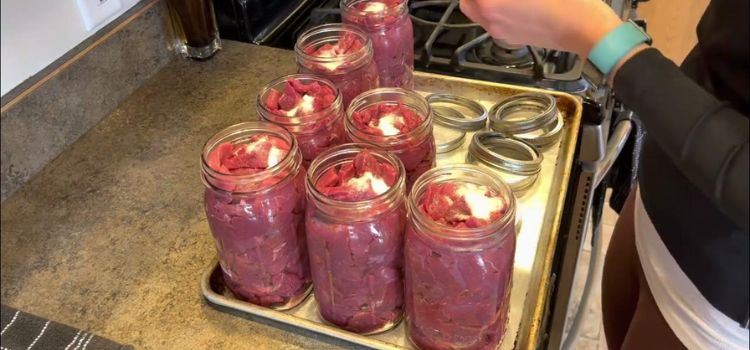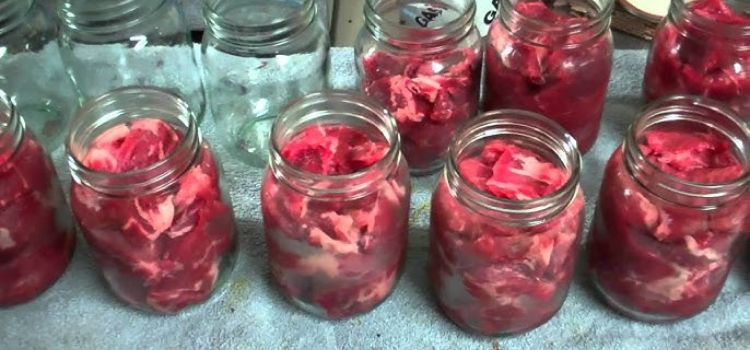As an Amazon Associate, I earn from qualifying purchases

Canning venison is a time-honored tradition that allows hunters and meat enthusiasts to preserve their bounty for future enjoyment. The appeal of canning goes beyond mere preservation; it taps into a desire for self-sufficiency, sustainability, and the pleasure of savoring richly flavored meats throughout the year.
However, the process can appear daunting, especially when you don’t have a pressure cooker at your disposal. This guide will walk you through the process of canning venison without a pressure cooker, offering a safe and effective method to ensure your venison is both delicious and shelf-stable.
Safety Considerations
Safety is paramount when canning meat, as improper methods can lead to foodborne illnesses. Traditionally, pressure canning is recommended for meats due to its ability to reach the high temperatures necessary to kill bacteria and spores. However, if you choose to use a water bath method, extra precautions are necessary.
Ensure your jars, lids, and rings are sterilized to prevent contamination. Always work with fresh, high-quality venison and maintain a clean workspace. It’s important to follow a proven recipe and method to minimize risks. While water bath canning is not typically recommended for meats, understanding the risks and implementing strict safety measures can help you proceed with caution.
Necessary Equipment
To can venison without a pressure cooker, you’ll need some essential tools:
- Jars and Lids: Use Mason jars specifically designed for canning. Ensure you have matching lids and rings.
- Large Water Bath Canner: This is a large pot capable of holding enough water to cover the jars by at least an inch.
- Jar Lifter and Funnel: These tools make handling hot jars easier and safer.
- Thermometer: Ensures your water reaches and maintains the correct temperature.
- Timer: Precision is key, so a reliable timer is essential.
Step-by-Step Instructions for Water Bath Canning

- Preparation: Start by trimming any excess fat from the venison and cutting it into uniform pieces. This ensures even cooking and a better texture.
- Seasoning: If desired, lightly season your venison with salt, pepper, or preferred spices. Avoid over-seasoning, as flavors intensify during canning.
- Sterilize Jars: Boil jars, lids, and rings for 10 minutes to sterilize them. Keep them hot until ready to use.
- Fill Jars: Pack the venison tightly into jars, leaving about an inch of headspace. Fill jars with boiling water or broth, leaving the same headspace.
- Sealing: Wipe the rims clean, place the lids on, and secure with rings. Do not overtighten, as air needs to escape during processing.
- Water Bath Processing: Place jars in the water bath canner, ensuring they are submerged by at least an inch of water. Bring to a boil and process for the time recommended in your recipe (usually 3-4 hours for meats).
- Cooling and Sealing: Carefully remove jars and let them cool. As they cool, you should hear the lids “pop,” indicating a proper seal. Check seals once jars are cool by pressing the center of the lid. It should not flex.
Seasoning and Flavoring Options
Canning is as much about flavor as it is about preservation. Here are some ideas to enhance your venison:
- Herbs and Spices: Consider adding bay leaves, thyme, rosemary, or juniper berries for an aromatic touch.
- Marinades: A simple marinade of red wine, garlic, and onions can infuse the meat with rich, savory notes.
- Experimentation: Feel free to experiment with small batches to find your preferred flavor profile, but remember that strong flavors can intensify.
Tips for Storing and Using Canned Venison
Once your venison is canned, store it in a cool, dark place such as a pantry or basement. Ensure that jars are not exposed to direct sunlight, which can degrade the contents over time.
When it comes to using canned venison, the possibilities are nearly endless. It can be used in stews, casseroles, or as a filling for savory pies. Its rich flavor pairs well with hearty vegetables like potatoes and carrots. Always inspect your canned venison before use; if the seal is broken or the contents appear or smell off, discard it.
Conclusion
Canning venison without a pressure cooker is a labor of love that requires attention to detail, safety, and a bit of culinary creativity. By following these guidelines, you can safely enjoy your preserved venison throughout the year. Embrace the process, experiment with flavors, and relish the satisfaction of a well-stocked pantry.
FAQ
What can I use if I don’t have a pressure cooker for canning?
If you don’t have a pressure cooker, you can use a large water bath canner for high-acid foods, but exercise caution with meats. For meats like venison, ensure thorough sterilization and follow recipes closely to minimize risks, keeping in mind that water bath canning is not typically recommended for meat.
How to can raw venison?
To can raw venison, trim excess fat and cut it into uniform pieces. Pack into sterilized jars, leaving headspace. Add boiling liquid, seal with lids and rings, and process in a pressure canner as per recommended times. Ensure jars are properly sealed before storing.
How long will canned venison last?
Canned venison can last for up to three to five years if stored properly in a cool, dark place. Always check the seal and condition of the jar before consuming. If any signs of spoilage are present, such as off-smells or broken seals, discard the contents.
As an Amazon Associate, I earn from qualifying purchases